Over recent centuries, humans have had a big impact on the wildlife of the UK. The landscape has been changed dramatically, with wild places destroyed, altered and fragmented. Some species have managed to adapt to these changes, but the majority have declined. The Wildlife Trusts are working hard to slow and reverse these declines, but some plants and animals have already been pushed too far, leading to local or even national extinctions.
Luckily, this doesn’t have to be the end of the story. In some cases, we can bring these lost species back to the areas they once called home. Reintroduction is the action of putting a species back into a former habitat. It can be achieved by restoring the habitat and then either relocating wildlife from an existing healthy population elsewhere in its range, or by raising wildlife in captivity, ready to release.
Reintroductions can be on a national scale, such as bringing beavers back to Britain after they were hunted to extinction across the whole country. They can also be at a local scale, returning a species to a county from which it has been lost, or even to a single location where it once thrived but no longer does. The Wildlife Trusts have worked on many successful reintroduction projects, from plants to mammals and insects – read on to discover a few of these fantastic comeback stories!
Back in Britain
These reintroduction projects have succeeded in the challenging task of bringing back a species that was completely lost from the country.
Beaver
Beavers are the celebrities of the reintroduction movement. Partly because they’re big, furry, and popular with wildlife watchers – but also because they’re a keystone species, whose presence can bring big benefits for other wildlife, and people too. Beavers were hunted to extinction in Britain in the 16th century, but The Wildlife Trusts have led on their reintroduction and they now have legal protection in Scotland and England. More than a dozen Wildlife Trusts across England, Scotland, and Wales have worked on, currently run, or are planning beaver projects..
Mike Symes
Northern pool frog
The northern pool frog became extinct in England in the 1990s, following decades of decline due to loss and damage to their fenland habitat. The situation was complicated, as pool frogs were originally thought to have been introduced by people, rather than naturally found in England. However, research revealed that pool frogs were actually a native species, and part of a rare group of northern pool frogs found only here and in Norway and Sweden. Sadly, by this point it was too late and the northern pool frog died out in England. The last known colony was at Norfolk Wildlife Trust’s Thompson Common nature reserve.
Norfolk Wildlife Trust worked with Amphibian and Reptile Conservation to plan the return of the northern pool frog to England. Closely related frogs from Sweden were reintroduced to a secret location in Norfolk, where they became established. A few years later, tadpoles from this site were used to establish a second population at Thompson Common, giving the frogs a firmer foothold in the county.
Northern pool frog © Jim Foster, Amphibian and Reptile Conservation Trust
Large blue butterfly
The large blue butterfly’s decline in the UK was a bit of a mystery. After meticulous study, PhD student Jeremy Thomas revealed that the large blue has a complex relationship with one species of red ant, which their caterpillars depend on to survive to adulthood. Unfortunately, the discovery came just too late. Changes in habitat management, as well as the loss of rabbit grazing due to myxomatosis, had led to this red ant being lost from the large blue’s remaining strongholds. As a result, the large blue became extinct in this country in 1979.
Once the mystery of the butterfly’s disappearance was solved, work was undertaken to create thriving populations of the red ant on which they depend – paving the way for the large blue to make a comeback. Natural England and the UK Centre for Ecology & Hydrology led an ambitious reintroduction programme, sourcing large blues from the population in Sweden.
Following their successful return to a site in Dartmoor, the project was expanded, working with a number of partners and landowners including Gloucestershire Wildlife Trust and Somerset Wildlife Trust. The southwest of England is now home to the greatest known concentration of large blues in the world, with Gloucestershire Wildlife Trust’s Daneway Banks thought to hold the world’s largest population.
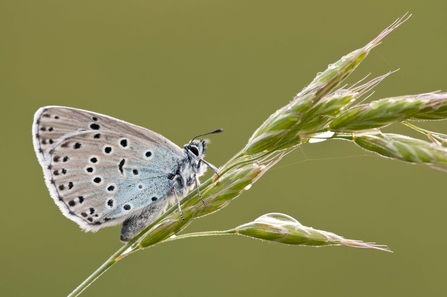
Large Blue ©Ross Hoddinott/2020VISION
Local lifelines
These reintroduction projects focussed on species that could still be found in parts of the UK, but were either lost from or struggling in particular areas. Restoring or bolstering regional populations helps prevent a species from being lost from the country completely.
Water vole
These iconic mammals have suffered huge declines as a result of pollution, habitat loss, and predation by American mink. Once a common sight in waterways across the UK, they have been lost from many parts of the country. Wildlife Trusts are working hard to save the remaining populations, but they’re also reintroducing water voles to some of the places they once lived. There have been successful reintroductions by Essex, Gwent, Herts and Middlesex, and Northumberland Wildlife Trusts.
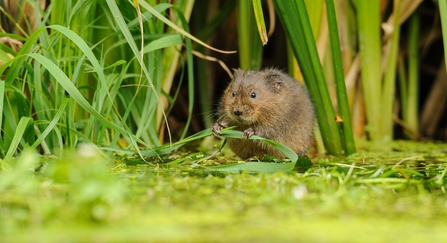
Terry Whittaker/2020VISION
Pine marten
Pine martens were once found across the UK, but habitat loss and persecution wiped them out from almost all of southern Britain. With protection under the Wildlife and Countryside Act, the Scottish population slowly began to recover. Pine martens were relocated from the growing Scottish population to help boost the isolated and endangered population in central Wales.
To help them make a return to southern England, Gloucestershire Wildlife Trust launched Project Pine Marten – a collaboration with partners across the county and region, including Vincent Wildlife Trust. Between 2019 and 2021, 35 pine martens were successfully reintroduced to the Forest of Dean. The hope is that these pine martens will connect with the expanding Welsh population and help establish a resilient pine marten population in the south-west of England.
Wildlife Trusts are working on plans for further potential pine marten reintroductions in southern England. Devon Wildlife Trust is part of the Two Moors Pine Marten Project, exploring the feasibility of returning pine martens to Exmoor and Dartmoor. Kent and Sussex Wildlife Trusts are assessing the possibility of returning pine martens to the southeast, as part of the South East Pine Marten Restoration Project.
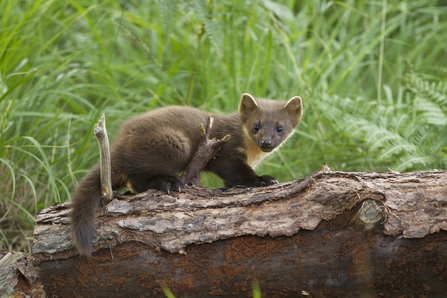
©Mark Hamblin/2020VISION
Southern damselfly
The southern damselfly is one of Europe’s rarest and most threatened damselflies, with very picky tastes in waterways. They like warm, shallow, slow-moving water. The loss of suitable habitat led the British population to decline dramatically. As populations became more isolated from each other, the risk of local extinction increased.
Southern damselflies declined in Devon and were lost from Venn Ottery, a Devon Wildlife Trust nature reserve, in 1989. Devon Wildlife Trust made great efforts to transform the site and create waterways suitable for the southern damselfly. When the habitat was right, hundreds of damselflies were relocated to Venn Ottery from a thriving population in the New Forest. The reintroduction was a success and, thanks to Devon Wildlife Trust’s ongoing habitat management work, southern damselflies are once again thriving at this special place.
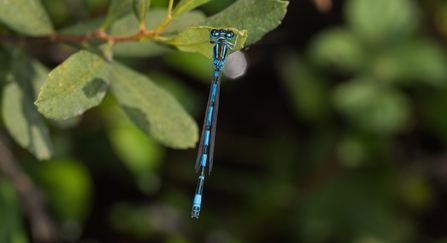
Southern damselfly © Brian Eversham
White-faced darter
These dashing dragonflies are lowland peatbog specialists. As peatbogs were drained for farmland, forestry, or other uses, the dragonflies disappeared. They became one of the UK’s rarest dragonflies, with just a few populations remaining.
Cumbria Wildlife Trust has helped them make a comeback in northern England, working with the British Dragonfly Society to reintroduce them to the Wildlife Trust’s Foulshaw Moss nature reserve. In 2010, larvae were collected from a donor site and transferred to pools at Foulshaw Moss. Following the success of this reintroduction, white-faced darters were introduced to another Cumbria Wildlife Trust nature reserve, Drumburgh Moss, in 2019.
It's not just Cumbria Wildlife Trust helping white-faced darters return. They had been absent from Cheshire for over a decade when Cheshire Wildlife Trust developed an ambitious plan to bring them back to Delamere Forest. Between 2013 and 2016, hundreds of larvae were moved to a mossland pool in Delamere from healthy populations in Shropshire and Staffordshire. The reintroduction was successful, as surveys show that white-faced darters are now breeding in Delamere Forest.
The white-faced darter reintroduction project is a partnership between Cheshire Wildlife Trust, the Forestry Commission, Natural England, the British Dragonfly Society and Cheshire West and Chester Council, with funding support from the Heritage Lottery Fund and the Linley Shaw Foundation.

White-faced darter © Vicky Nall
Oysters
The native oyster, also known as the flat oyster, can filter a bathtub’s worth of water every day, helping to improve the water quality of our seas. They also form reefs, which can be home to many other species. Sadly, oyster populations are estimated to have declined by 95% since the 19th century, making oyster reefs one of Europe’s most threatened habitats. The decline is the result of a range of factors, including overfishing, pollution, and habitat loss.
The native oyster was considered to have gone extinct in Belfast Lough, Northern Ireland, in 1903. However, in 2020 live oysters were discovered there for the first time in over 100 years. To help the oysters make a comeback, Ulster Wildlife created an oyster nursery in Bangor Marina. In 2022, around 700 mature oysters were suspended in cages under pontoons of the marine. These oysters will generate millions of larvae, which will settle on the seabed and help oysters return to Belfast Lough. A team of dedicated volunteers help look after the oysters and conduct regular health checks.
The Humber Estuary, on the east coast of England, was once home to one of the largest oyster populations in the UK. But a pollution incident in 1904 marked the start of a rapid population decline, and by 1940 oyster stocks in the Humber were extinct. By 2018, the Humber had seen a vast improvement in water quality and plans were made to restore its lost oyster population.
A partnership between Yorkshire Wildlife Trust and the University of Hull was formed to assess whether conditions were suitable, and a reintroduction trial began on the foreshore at Spurn Point nature reserve. The trial was a success and proved that oysters can survive again in the Humber Estuary, with thousands of oysters reintroduced.
The restoration of the Humber’s habitats is now being continued by Wilder Humber, a partnership programme between Yorkshire Wildlife Trust, Lincolnshire Wildlife Trust, and energy company Ørsted. In addition to boosting the fledgling oyster population, Wilder Humber aims to restore seagrass meadows and other marine and coastal habitats, trialling a “seascape-scale” model of conservation.
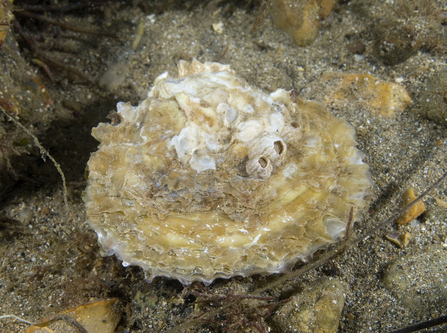
Oyster ©Paul Naylor
Pond mud snail
These miniature snails typically live in wetland habitats that dry up or have much lower water levels in summer. This includes small ponds, marshes, and ditches. They’re excellent recyclers, feeding on dead vegetation and putting nutrients back into the wider food chain. They were once widespread in Britain, but have declined dramatically and are now only found in a few regions, including a handful of Scottish sites.
In 2018, the Royal Zoological Society of Scotland released more than 80 snails at the Scottish Wildlife Trust’s Red Moss of Belerno wildlife reserve. Five years later they celebrated the news that the snails were still present on the reserve, an encouraging sign that the reintroduction had been a success. Further releases are planned at the nature reserve, to improve the pond mud snail’s conservation status in Scotland.
Pond mud snails © Paul Baker
Greater water parsnip
Greater water parsnip was once a widespread plant of wetland areas in England and Northern Ireland. However, over the past 40 years populations have shrunk to 50% of their former range as a result of habitat loss and changes in wetland management. In England, it is now found only in a small number of isolated wetlands and considered vulnerable to extinction.
The Yorkshire population of greater water parsnip is scattered and fragmented. To help grow a diminished population in the Derwent Valley, Yorkshire Wildlife Trust has reintroduced the plant to their Wheldrake Ings nature reserve. The individual plants were cared for from seed at Yorkshire Water’s Tophill Low nature reserve, before being transplanted to carefully chosen sites at Wheldrake Ings.
Lincolnshire Wildlife Trust has also reintroduced greater water parsnip to a number of wetland nature reserves, whilst Somerset Wildlife Trust has worked with Bristol Zoo Gardens on a project to return greater water parsnip to nature reserves in the Somerset Levels, alongside another rare plant – devil’s-bit scabious.
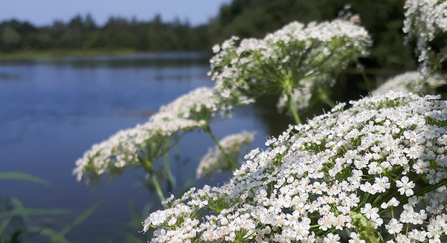
Greater water parsnip © Rachel Shaw
Fen raft spider
This is one of the UK’s rarest spiders, which until recently was only found at two sites in England and one in Wales. To help ensure the future of the species, it was decided that the fen raft spider needed a helping hand to establish in new areas. This project wasn't strictly a reintroduction, as not much is known about the historic distribution of the fen raft spider, but it was deemed likely to be able to thrive at Suffolk Wildlife Trust’s Castle Marshes nature reserve – an area of suitable habitat on the same river as the existing population at Redgrave and Lopham Fen, also a Suffolk Wildlife Trust nature reserve.
In 2010, female spiders with eggs sacks were collected from Redgrave and Lopham Fen, as well as from Sussex Wildlife Trust’s Pevensey Marshes nature reserve. The spiderlings were nurtured in project leader Dr Helen Smith’s kitchen, before around 2,800 spiderlings were released at Castle Marshes to kick-start a new population. This was followed in 2011 by the release of over 1,000 spiderlings at another Suffolk Wildlife Trust reserve, Carlton Marshes, downstream from Castle Marshes. Monitoring of the fledgling populations showed that they were both growing and expanding – a successful introduction.
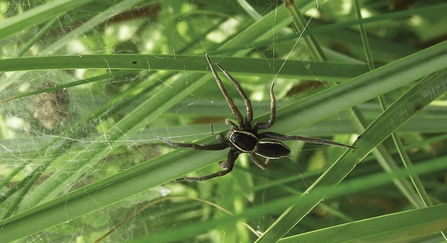
Fen raft spider © Helen Smith



